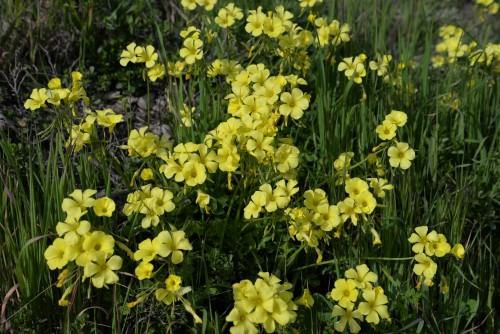

For the genus as a whole, the term oxalises is also used. Other species are colloquially known as false shamrocks, and some called sourgrasses. Some species are called yellow sorrels or pink sorrels after the color of their flowers instead. Many of the species are known as wood sorrels (sometimes written "woodsorrels" or "wood-sorrels") as they have an acidic taste reminiscent of the sorrel proper (Rumex acetosa), which is only distantly related. The genus occurs throughout most of the world, except for the polar areas species diversity is particularly rich in tropical Brazil, Mexico and South Africa. Seeds and creeping aboveground horizontal stems that root at stem joints (nodes).Oxalis is a large genus of flowering plants in the wood-sorrel family Oxalidaceae, comprising over 550 species. When seeds mature, capsules open explosively, often spreading seeds 10 feet (300 cm) or more. Seeds are egg shaped, flat, brown, have transverse ridges, and are roughly 1/16 of an inch (1.6 mm) long. Each capsule ranges from 1/4 to 1 inch (0.6–2.8 cm) long and contains a few to numerous seeds. Fruitsįruit consist of green cylindrical capsules (similar to pods) that either have five weak lobes or are angled and attach to stalks that stand erect or curve downward. Creeping woodsorrel has less upright growth and less showy flowers than Bermuda buttercup, a similar looking plant. The small flowers have five yellow petals. Two to five yellow flowers form a cluster that develops where leaf stalks and stem meet (leaf axil). Flowersįlowers are present almost year-round. Leave are gernally green but a variant with purplish leaves is also common. Leaves are alternate to one another along the stem and usually fold downward at midday and at night. In comparison to the leaves, leaf stalks are long, almost 3 inches (7 cm) in length. Hairless to sparsely hairy, leaves are fully subdivided (compound), each consisting of three heart-shaped leaflets that are 1/4 to 2/5 of an inch (0.6–1 cm) long and 1/6 to 1 inch (0.4–2.5 cm) wide. Leaves resemble those of clover and range from green to dark purple-tinged.

Its creeping, aboveground horizontal stems grow to about 12 inches (30 cm) long and root at the stem joints (node) allowing it to invade new areas.

The first leaf has three leaflets that are broadly heart shaped. Leaves are alternate to one another along the stem. They range from 1/12 to 1/5 of an inch (2–5 mm) long and 1/25 to 1/10 of an inch (1–2.5 mm) wide. The cotyledons (seed leaves) are oval to egg shaped and hairless, except for minute hairs along the edges that point upward. Yards, gardens, turf, landscaped areas, urban places, orchards, vineyards, fields, and agricultural crops, and nursery and greenhouse grounds and containers. Bermuda buttercup prefers shady conditions but can grow in sun. Both species contain variable levels of oxalate compounds that when eaten in quantity, can cause death in livestock. It is related to, and closely resembles Bermuda buttercup (buttercup oxalis). It grows throughout California to 8200 feet (2500 m) and inhabits agricultural land, greenhouse and other disturbed sites. Creeping woodsorrel is a low growing perennial broadleaf plant with shamrock-like leaves.


 0 kommentar(er)
0 kommentar(er)
